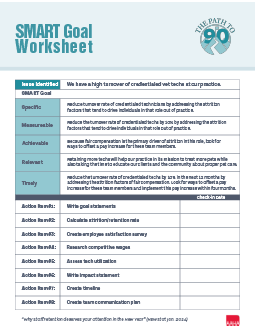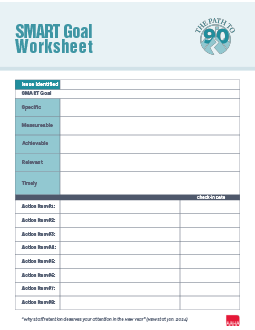Why staff retention deserves your attention in the New Year

Whether you’re all-in on New Year’s resolutions or you’re simply always looking for ways to level up, now is a great time to look at your staff retention rate with a critical eye. How often is your practice losing good employees? How long does it take to replace them? And how is that impacting your clients, your business, and your team?
In 2023, AAHA surveyed nearly 15,000 veterinary professionals from all practice roles and learned that, among those currently in clinical practice, 30% plan to leave their current job within the coming year. Some were open to a job at a different practice, others planned to work in vet med outside the clinic, and others intended to leave the profession entirely.
[Sign up here to be among the first to receive our upcoming 2024 retention white paper.]
Regardless of where they’re going, the fact remains that turnover is expensive; Gallup estimates the cost of replacing an individual employee as ranging from half to double the employee’s annual salary (or more).
Perhaps more important is the impact of high turnover on teams, especially when you lose harder-to-replace employees like associate DVMs and technicians. Until those jobs are filled, the remaining team members have to pick up the slack; meanwhile, clients may get cranky when it’s harder to make an appointment because you’re short-staffed. All of this increases stress, which can lead to burnout—and that’s a fast track to driving even more good employees away.
Why people leave (and stay)
The AAHA Path to Improved Retention Study, which you’ll read more about in the upcoming white paper, identified the factors veterinary professionals consider most important in the workplace.
- Some of the factors identified are strong attrition drivers, meaning that people are likely to leave when these needs aren’t met.
- Some factors impact both retention and attrition strongly: When these needs aren’t met, they’re a big reason for leaving, but when they’re done well, they inspire people to stick around.
- Others are compelling retention drivers, meaning the people who plan to remain where they are consider them major factors in making them want to stay.
If you’re ready to pay attention to retention, the following suggestions will help you get smart about the right steps to take. Stay tuned to AAHA publications throughout 2024 for more tips and resources to help your practice take the step toward 90% retention, and a brighter future for the whole profession.
A smart way to stick to your retention improvement goals
One of the biggest mistakes we can make when setting goals (New Year’s resolutions or otherwise) is being too broad. “I want to improve retention in my practice,” is a nice idea, but not a strong goal. If you can be clearer on exactly what you want to accomplish, that will get you closer to actually achieving it.
SMART goals can help identify where you want to go and what’s needed to make it happen. While your goals will vary based on your practice’s current and future needs, the following examples illustrate how to use the SMART goal technique to make your goals Specific, Measurable, Achievable, Relevant, and Timely.
How to make goals “Specific”
What exactly do you want to accomplish? Improved retention rates, yes—and, in fact, we’d suggest aiming to reach a 90% retention rate, which suggests strong retention but leaves enough room for necessary turnover. But, you’ll need a little more detail to create the right strategy.
Action #1: Write your practice’s specific goal statements
For starters, are you in a situation where you’re seeing:
- High turnover across the board? You’ll want to slow turnover across all roles.
- High turnover in a specific role or two? You should aim to reduce turnover in those roles.
- Reasonable turnover, but you’d still like to improve? You actually want to increase retention and improve practice loyalty among your people.
These subtle differences strongly impact the approach you’ll want to take and the solutions you need to implement to make lasting change.
Sample goal (specific)
- Reduce turnover rate of credentialed technicians by addressing the attrition factors that tend to drive individuals in that role out of practice.
How to make goals “Measurable”
How can you measure success in your goal? The clearest place to start is with your current attrition or retention rate (which you can learn about calculating here). But you may be able to keep it quite simple.
Click to Download: Sample Goals Handout for
|
Action #1: Calculate your attrition/retention rate
For example, if a 30-person practice has an average turnover rate of 30%, that’s nine or 10 people a year. Aiming to reduce that attrition rate to 20% (six people leaving a year) could be a great place to start. Your ultimate goal can still be to reach 90% retention, but it’s more manageable to start small.
Action #2: Quantify employee satisfaction with a score
Another metric you could focus on is employee satisfaction. Allowing your team to provide feedback, perhaps anonymously in a survey, can give you a clear understanding of who’s happy where they are, who’s not—and, as a bonus, you can even give them a chance to tell you what changes would make the biggest impact on their satisfaction. To make it measurable, you’ll need a way to quantify those responses so you can pinpoint how big an improvement you want to see in that score by your next survey.
Sample goal (measurable)
- Reduce the turnover rate of credentialed technicians by 10% by addressing the attrition factors that tend to drive individuals in that role out of practice.
How to make goals “Achievable”
What resources or tools do you need to achieve your goal? What changes must be made?
A lack of fair compensation is the strongest driver of attrition in just about every role in practice, and for technicians, that’s especially true. So, if you’re going to focus on improving factors that are likely to make the biggest difference for vet techs, it makes sense to start with fair pay.
Action #1: Research wages in your area
That requires an understanding of what “fair compensation” really means. Resources like the MIT Living Wage Calculator, along with data on what other practices in your region are paying, can help narrow it down. It’s not just about remaining competitive with local practices; if vet techs in your area can’t earn a living wage in clinical practice, they’re more likely to switch to a career where they can, even if it’s outside vet med.
Action #2: Assess technician utilization at your practice
Of course, it takes money to pay folks more, right? Consider what you might be able to adjust to avoid this hurting your budget. For example, try increasing technician utilization. Practices that utilize their techs to their full abilities show an average revenue increase of 36%—plus it helps to increase job satisfaction among those techs!
Offering (and charging for) tech appointments (or telehealth appointments that your technicians are legally allowed to handle) could be another way to offset the cost of a pay increase for these valuable team members.
Sample goal (achievable)
- Reduce the turnover rate of credentialed technicians by 10% by addressing the attrition factors that tend to drive individuals in that role out of practice.
- Because fair compensation is the primary driver of attrition in this role, look for ways to offset a pay increase for these team members.
How to make goals “Relevant”
What’s the big picture version of why you’re setting this goal? It’s not just so you don’t have to keep recruiting, hiring, and training new technicians (although that’s certainly part of the reason!). Reducing turnover in this role benefits the whole practice because being part of a staff that works as a team is a major retention factor—and you can’t build a solid team if you’re constantly losing and replacing its members. Plus, when team members aren’t leaving unexpectedly, you’re less likely to experience ongoing staff shortages—and that benefits not only the team, but the clients, patients, and the business.
Action #1: Write an impact statement for your goal
Think about how achieving this goal will impact your practice’s mission, vision, and culture—this should help you understand how relevant it is.
Sample goal (relevant)
- Reduce the turnover rate of credentialed technicians by 10% by addressing the attrition factors that tend to drive individuals in that role out of practice.
- Because fair compensation is the primary driver of attrition in this role, look for ways to offset a pay increase for these team members.
- Retaining more technicians will help our practice in its mission to treat more pets while also taking the time to educate our clients and the community about proper pet care.
How to make goals “Timely”
By when do you want to accomplish this? Or, put a little differently, over what time period do you want to track your progress?
Action #1: Map out a timeline for your goal
With a goal like improving retention or reducing attrition, there are multiple parts: The implementation of changes that will lead to the overall goal, and the goal itself. Start backward from your target date and identify check-in points along the way, including who is accountable for gathering any of your measurable data to report on your progress.
Action #2: Create a team communication plan
By communicating with your team about your goal, along with providing transparency about the steps you’re taking and the timeline, simply setting (and sharing) your intention to make these changes could impact the very people you’re hoping to retain. (You still have to follow through, though, or this will backfire spectacularly.)
Sample goal (timely)
- Reduce the turnover rate of credentialed technicians by 10% in the next 12 months by addressing the attrition factors that tend to drive individuals in that role out of practice.
- Because fair compensation is the primary driver of attrition in this role, look for ways to offset a pay increase for these team members and implement this pay increase within four months.
- Retaining more technicians will help our practice in its mission to treat more pets while also taking the time to educate our clients and the community about proper pet care.
Stay tuned for more in 2024!
Improved retention is a smart place to focus your attention in the coming year. And AAHA will be paying plenty of attention to it, too, with a white paper, webinars, and deep dives into various solutions shared in our publications throughout 2024.
Click to Download: Blank SMART Goals Worksheet for
Your Team
Stay tuned for more on how to improve retention in your practice—and in the meantime, if you’re facing specific turnover challenges or have retention solutions you’d like to share, please reach out to us at [email protected].
Kristen Green Seymour is AAHA’s copywriter and lead writer on AAHA research projects.
Cover photo credit: © didesign021 E+ via Getty Images Plus
Disclaimer: The views expressed, and topics discussed, in any NEWStat column or article are intended to inform, educate, or entertain, and do not represent an official position by the American Animal Hospital Association (AAHA) or its Board of Directors.
NEWStat Advancements & research News Interesting/unusual Practice management





